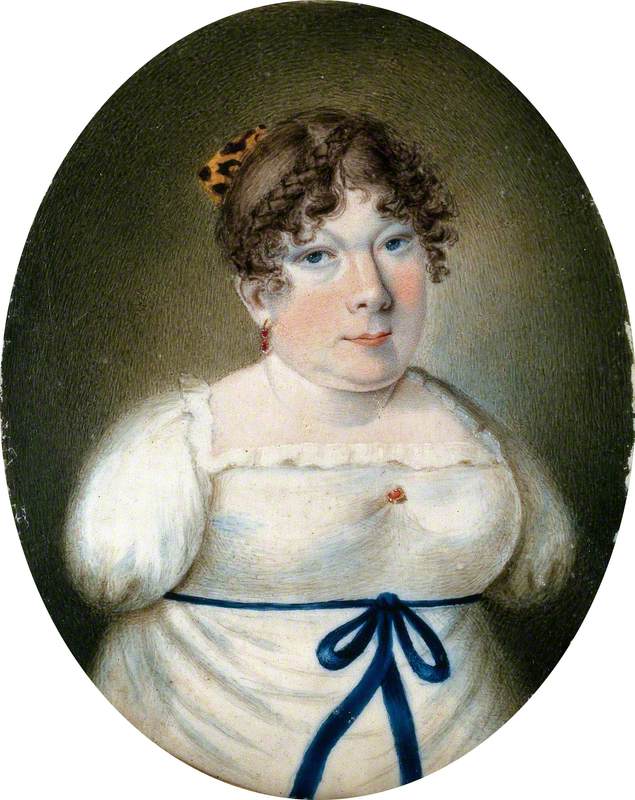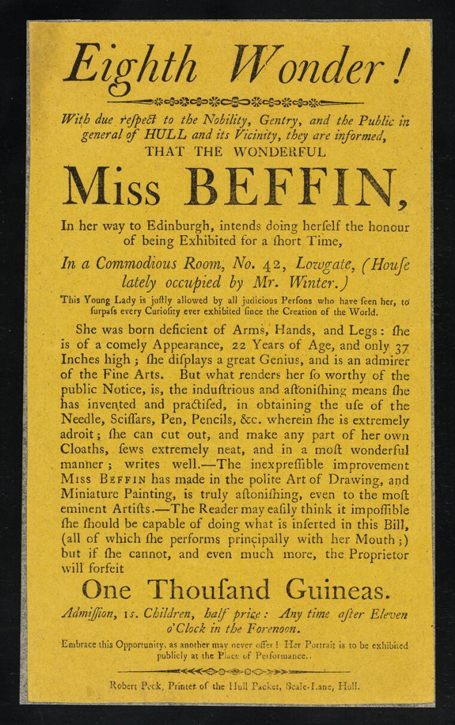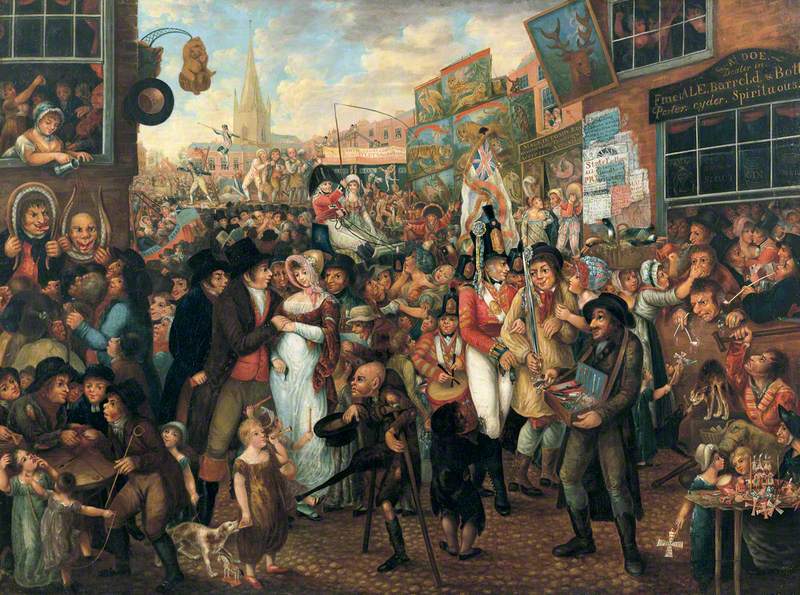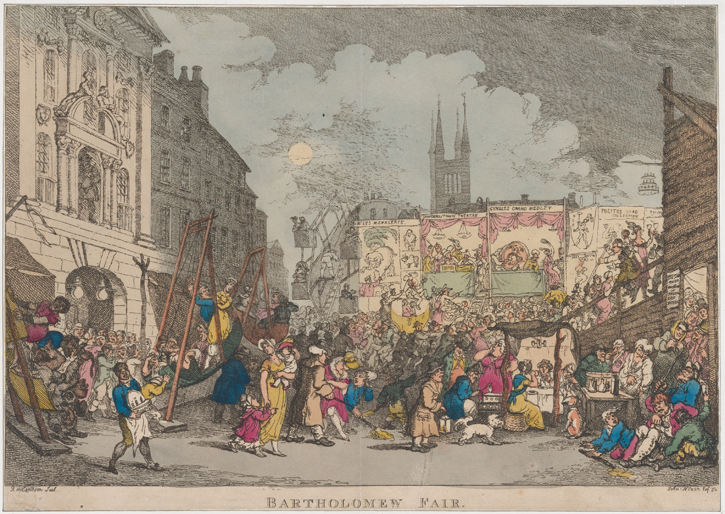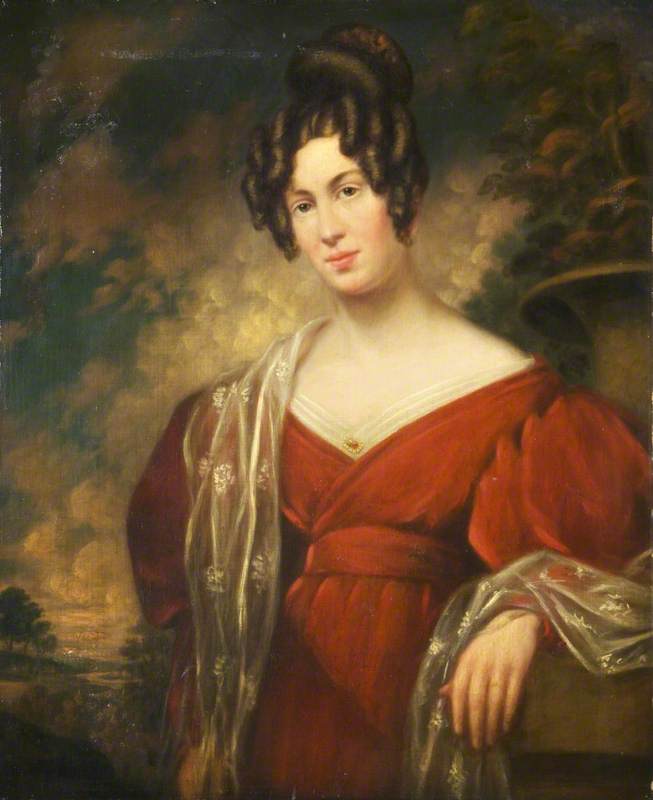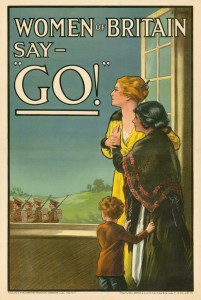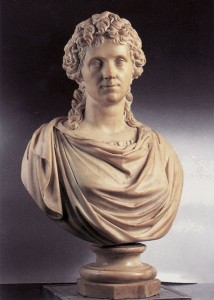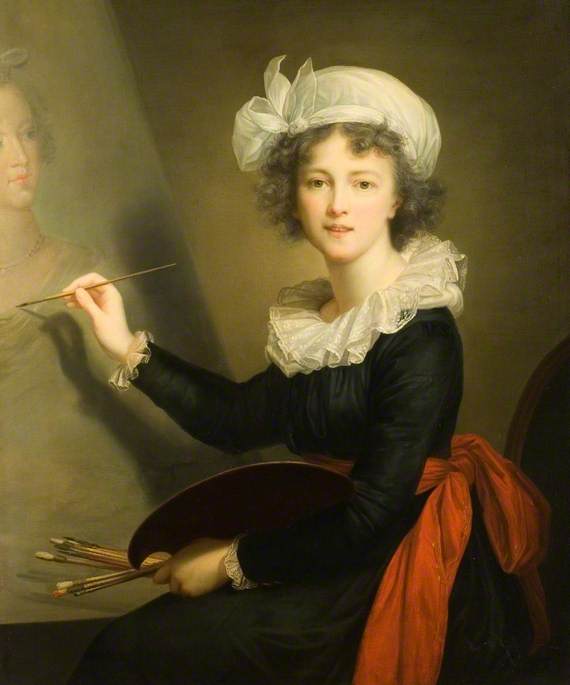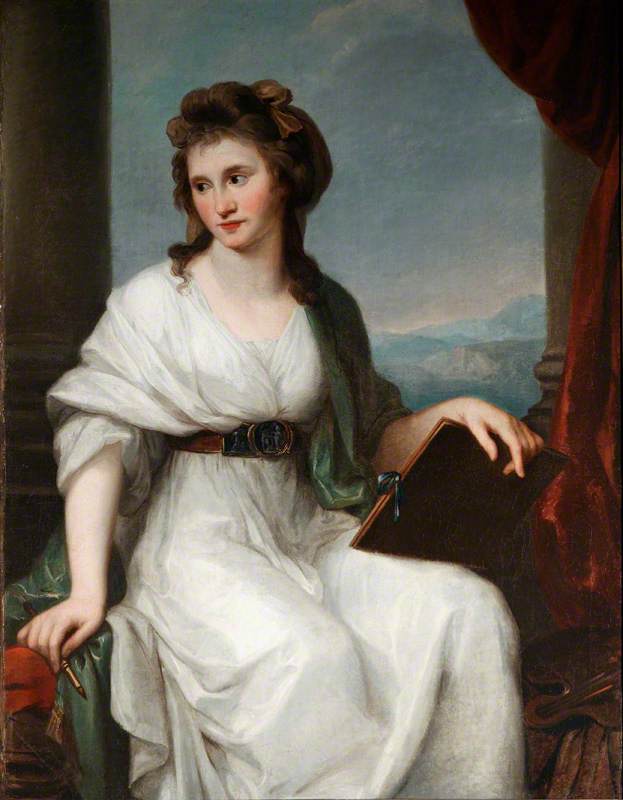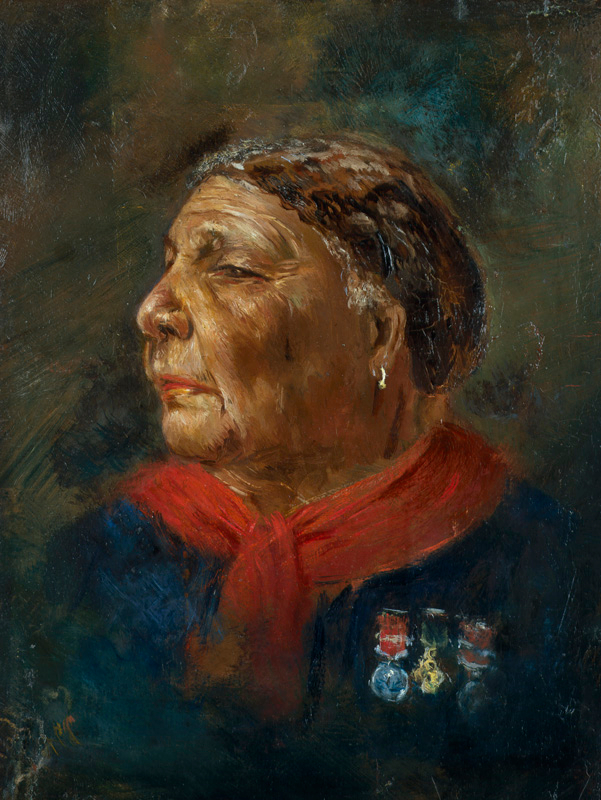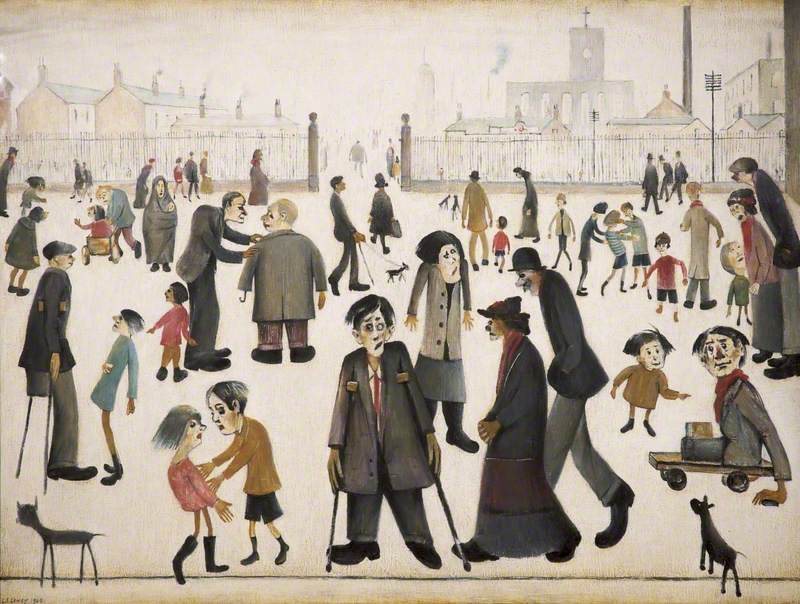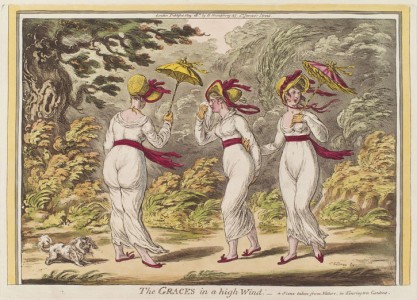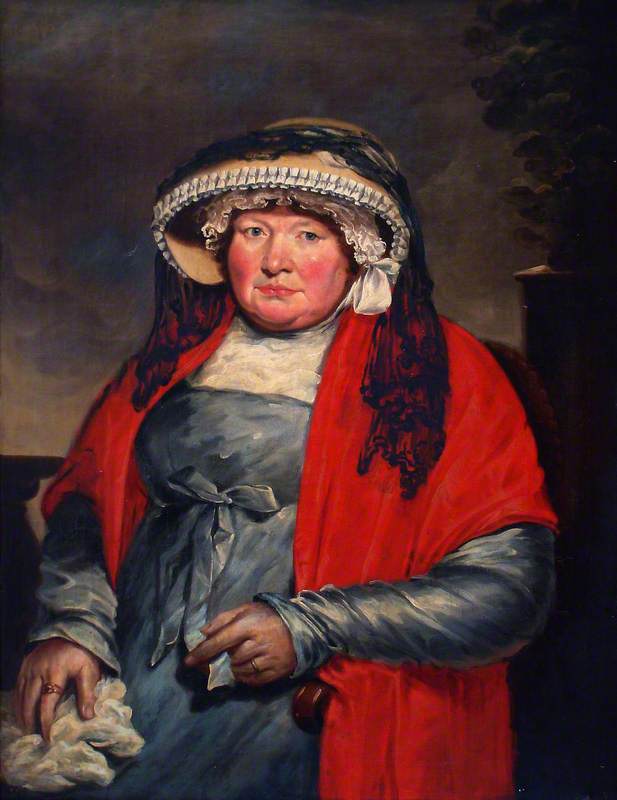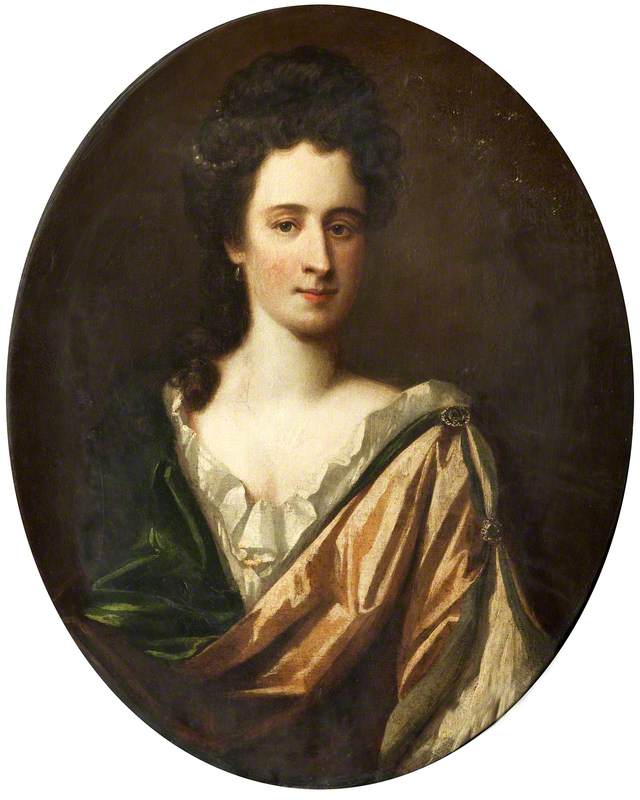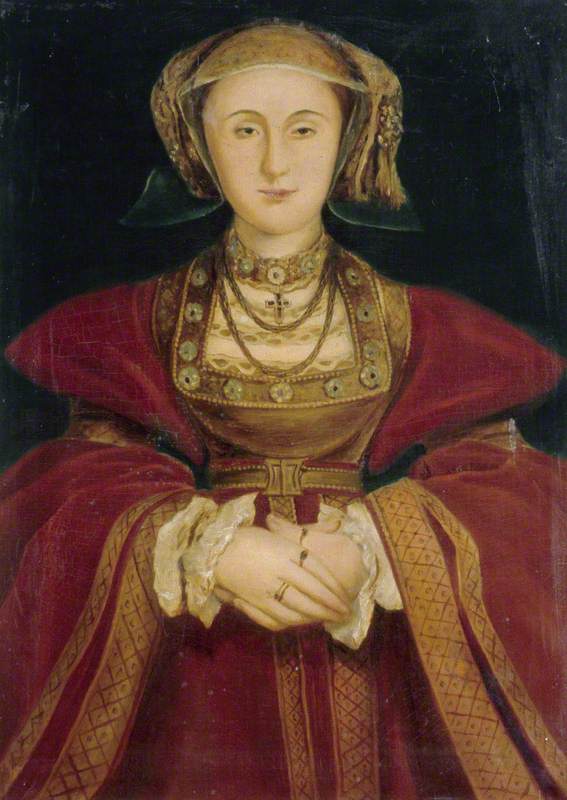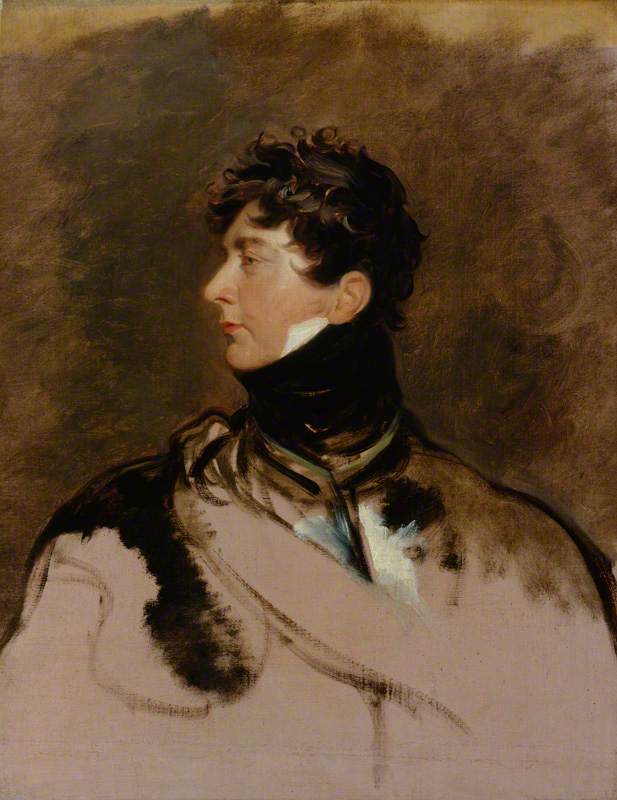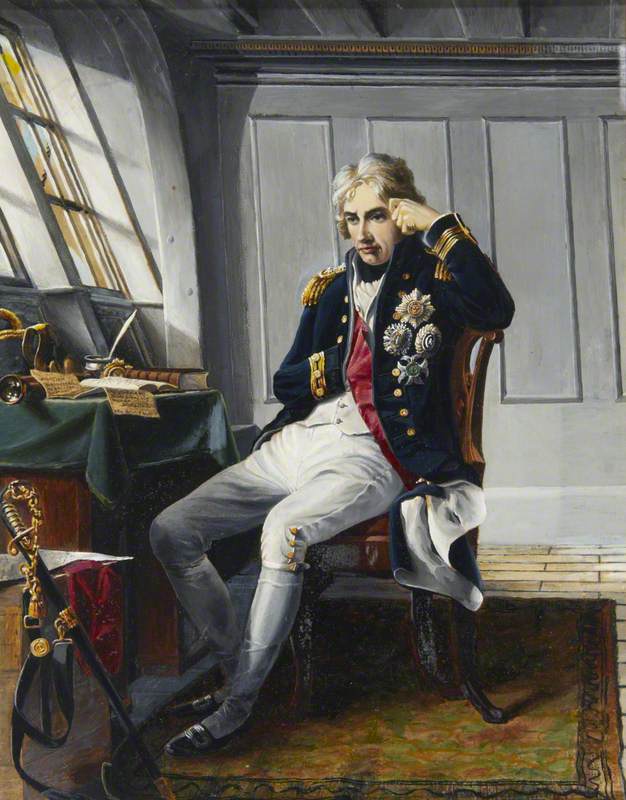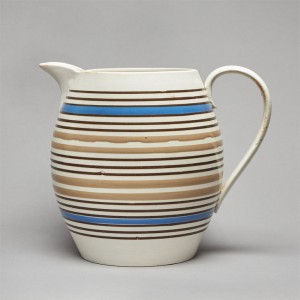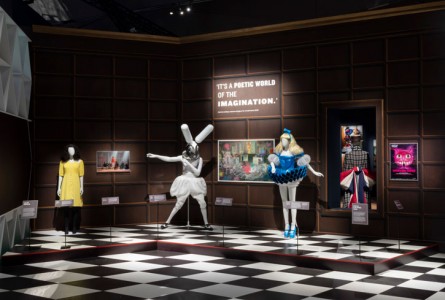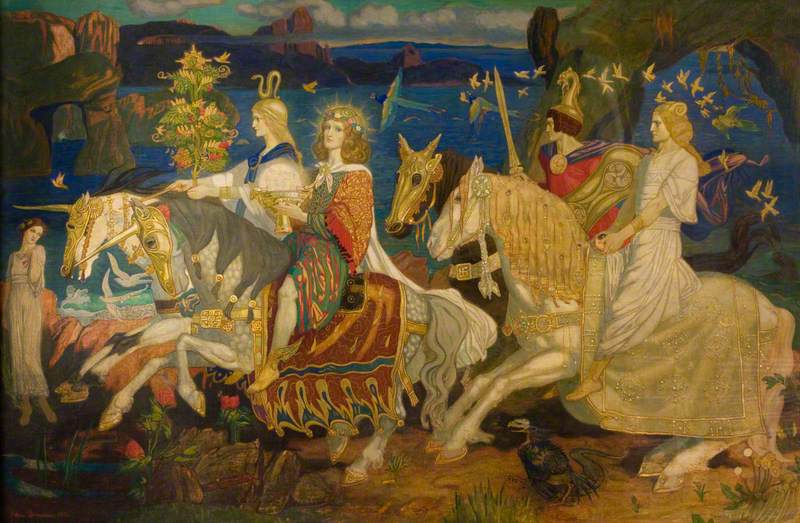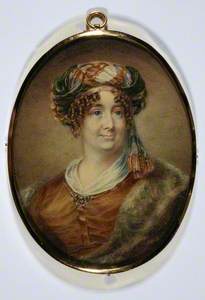The artist Sarah Biffin (1784–1850) came from humble origins, though by the time of her death, she was a celebrated miniaturist. As a disabled woman artist working in the early nineteenth century, her remarkable story is one of perseverance and resilience.
'Miss Biffin. Miniature Painter Born without Hands'
lithograph by G. Engelmann (1788–1839) 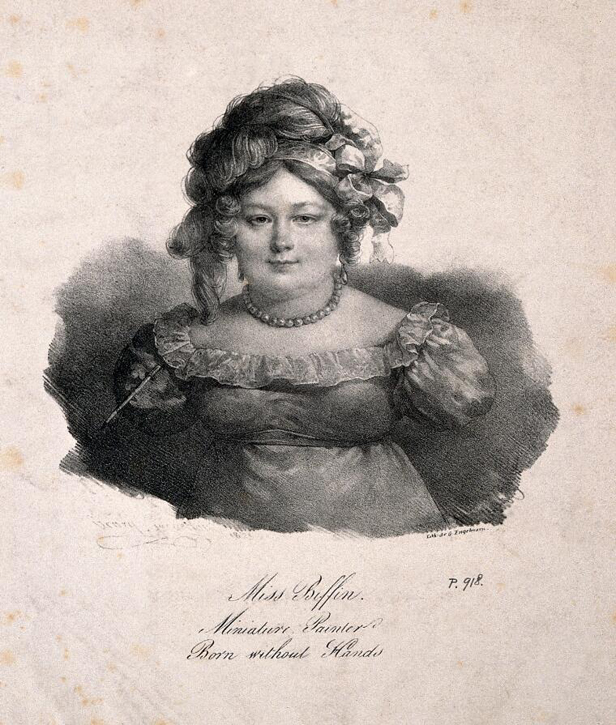
Her parents, Henry and Sarah, lived in a labourer's cottage in East Quantoxhead, near Bridgwater in Somerset. She was the middle child of five, and her parents' first daughter. Biffin's baptism certificate records that she was 'born without arms and legs'. Nevertheless, she learnt to write, sew, use scissors, and became a professional artist, painting miniatures of the British royal family, the aristocracy, and the wealthy.
Biffin painted her own portrait several times. Her undated miniature watercolour self-portrait in an empire line dress is in the Wellcome Collection. It is one of the earliest of her self-portraits, and one of the few in which her disability is visible. Biffin's hairstyle echoes that of the sitter on the right of John Smart's (1741–1811) watercolour miniature Miss Harriet and Miss Elizabeth Binney (1806).
Her 1830 self-portrait in the National Gallery of Scotland depicts a more mature Biffin with turban and front curls. The latter painting reminiscent of Henry Wyatt's A Regency Lady (1828).
Biffin began her career exhibiting her skills as a curiosity. Her parents placed her under contract with Emmanuel Dukes, a showman who exhibited at fairs. Biffin was sometimes billed as 'the eighth wonder' or 'the limbless wonder.' By her own account, however, Mr and Mrs Dukes treated her well, and she lived with them as part of the family.
Biffin performed regularly at Bartholomew Fair, the three-day festival at Smithfield in London. William Wordsworth attended the fair in 1802. He includes his experience in his poem The Prelude (1805).
Overwhelmed by the advertising posters and the strangeness of the exhibits, Wordsworth writes that he was surrounded by 'staring pictures and huge scrolls, / Dumb proclamations of the prodigies'. He experienced the din of hurdy-gurdy grinders, fiddlers, and drummers, theatrical booths, and other exhibits, such as 'the learned pig' who could do addition and predict the future, stone eaters and fire swallowers, performers with unusual bodies. The whole event produced in him the sensation of a 'perpetual flow / Of trivial objects... that have no law, no meaning, and no end'.
Although it is unknown whether Wordsworth saw Biffin perform, Thomas Rowlandson's 1799 etching of Bartholomew fair includes a poster image of her. Rowlandson positions an advertising sketch of her on a staircase beneath another poster advertising a man spinning plates on the end of a sword with one hand and juggling with the other. The juxtaposition must have been deliberate.
While working at the fairs, Biffin demonstrated her sewing skills, cut out and made clothes, gave out writing samples, and painted portraits. The Bodleian Library has a specimen of her writing. From 1804, Biffin took commissions, as she began her professional career as an artist. Dukes was her first art instructor, and she stayed under his tutelage until around 1816.
Biffin's formal instruction in art began in 1808, after a chance encounter with George Douglas (1761–1827), Earl of Morton at one of the fairs. The Earl commissioned a miniature portrait of himself from Biffin. To make sure that she was honest, he took the painting home with him after each sitting. Impressed by her talent, he sponsored her tuition at the Royal Academy of Arts, where Biffin studied under William Marshall Craig, an artist with important royal patrons.
The Earl's presentation of Biffin's work before George III led to further commissions, including a miniature of the Duke of Kent (1839) bought by his daughter, Queen Victoria, and now in the Royal Collection. The miniature of the Duke is sometimes described as a copy of George Dawe's portrait (1818). There are, however, distinct differences, and Dawe's painting served as a model for a number of portraits painted by various artists after the Duke's death in 1820.
Success came in 1821, when Biffin won the large silver medal at the Royal Society of Arts for a historical miniature. From this year on, she regularly exhibited her work at the Royal Academy of Arts and opened a studio in the Strand in London. A few years later, Biffin married William Stephen Wright on 6th September 1824. Wright was possibly a lieutenant in the Royal Navy. Biffin's death certificate, however, suggests that she was the widow of a banker's clerk, which may have been his second career.
The media was always fascinated by how Biffin performed ordinary tasks. For example, one American journal included an item on how her wedding ceremony was conducted, stating that 'Mr. W. was desired to hold the ring against the shoulder of the lady, and afterwards, having put it on a gold chain which she wore around her neck, it was placed in her bosom'. Several commentators note that the couple separated soon after they married, though the Evangelical Lutheran Intelligencer remarks that Wright 'had long been attached to' Biffin.
Biffin frequently appears in published memoirs. Julia Clara Byrne, the wife of William Pitt Byrne, the proprietor of The Morning Post, includes a story about her in Gossip of the Century (1892). Biffin lived in Brighton in the Old Steine at the time of Byrne's description of her: 'She painted with a fine miniature brush which was fixed to the stump of what would have been her right arm and it was surprising to note how minute was the finish of her work'.
Byrne was present shortly after Biffin had finished her portraits of George IV and Mrs Fitzherbert, who were living in Brighton at the time. Biffin, Byrne writes, 'was considered by connoisseurs an artist of much ability and the King's patronage brought her work into repute'. At some point in her career, Biffin was granted a small pension, possibly by William IV, and this was paid until her death.
Biffin's technique is also described by Edward Boys Ellman in Recollections of a Sussex Parson (1912). Ellman's cousin, Frances Sankey (later Mrs Ottaway), and his sister Catharine, both took lessons in miniature painting from Biffin while she was in Brighton in 1829. Ellman describes Biffin as:
'... a heavy looking woman; she wore a turban and was always seated on a sofa. Her paint brush was pinned to a large puff sleeve which covered the short stump of the upper part of the arm. She fixed and removed the paint brush with her teeth, when necessary to wash the brush. When painting she leant her right shoulder forward, almost touching the table. She declared that she considered that for painting she had the advantage of those who had arms, for surely it was easier to paint with a short brush than with a long stick!'
Ellman recalls that her man-servant would carry her when she needed to move, and that she 'suddenly disappeared from Brighton greatly in debt'. The debts are something of a mystery, though her civil-list pension and the annuity from her estranged husband were modest.
Biffin lived and worked in many places around England, including London, Brighton, Bath, Cheltenham and Liverpool. The 1841 census records that she lived in the High Street in Cheltenham at that time. Biffin is likely to have moved to Liverpool shortly after this, due to her financial troubles. She lived at 8 Duke Street and exhibited her work there.
In 1847, Richard Rathbone, a Liverpool philanthropist, began an appeal for a subscription to purchase an annuity for Biffin. As part of this campaign, Biffin wrote to Charles Dickens seeking a donation. Dickens' reply of 27th October 1847 survives. He declined to send her money, on account 'of the enormous number of similar applications of which' he was 'in continual receipt'.
Dickens nevertheless refers to Biffin several times in his novels and articles, often making fun of her appearance (see Nicholas Nickleby, The Old Curiosity Shop, Martin Chuzzlewit, Little Dorrit, 'A Plated Article' [Household Words, 1852], and an 1851 sketch for comical book spines, which reads 'Miss Biffin on Deportment'). Contributors to Biffin's fund included the singer Jenny Lind and the actor William Charles Macready.
Biffin knew some of the leading lights of the theatre world. In 1844, Anne Mathews recounts an anecdote about the celebrated conjurer Thomas Ingleby inviting Miss Biffin to his performance, but forgetting that he had promised to escort her home. The man who locked the building eventually found her patiently waiting. As a large cloak hid her body, he could not understand why she had not left the theatre. A similar story circulated in The New Monthly Magazine in 1836, however, with Wright as the forgetful companion.
Biffin makes brief appearances in letters and literary works of leading figures of her age. Most of these references mention her disability in disparaging ways. Hester Thrale Piozzi, however, speaks of her in a striking moment, where she speculates on what the body has the potential to do. Complaining about having a sore throat in a letter of 28th January 1818, Piozzi speculates that in a few years illnesses 'will be made easy; Miss McEvoy sees with her finger tips, and Miss Somebody [Biffin] embroiders with her shoulder and elbow; no need of hand and arms for the old purposes, say the improvers of the world'.
Biffin and McEvoy immediately put Piozzi in mind of Mary Shelley's Frankenstein, which had been published on 1st January 1818. Just as McEvoy and Biffin adapted to alternative ways of functioning, Piozzi thinks that science will assist in this, as it does in Frankenstein. Shelley's novel, she suggests, pushes the boundaries in 'an audacious, and I might add, such an ingenious piece of impiety'.
Miss S. Biffin
1821, engraving by Robert William Sievier (1794–1865) after Sarah Biffin (1784–1850) 
Elsewhere in literary texts, she appears in Thomas Hood's poems Ode to the Great Unknown (1825) and The Mermaid of Margate (1826) briefly, in William Makepeace Thackeray's 'A Grumble about the Christmas Books' (1847), and Rhoda Broughton's gothic short story, 'The Truth, the Whole Truth, and Nothing but the Truth' (1868). More recently, in 2001, the Merseyside poet Matt Simpson devoted a poem to her.
Sarah Biffin died on 2nd October 1850 at the age of 66. She is buried in St James's cemetery in Liverpool. Biffin continued to paint up to her last days. A few months before she died, she exhibited a portrait at the 1850 Royal Academy of Arts exhibition.
Essaka Joshua, Associate Professor of Romantic and Victorian Literature at the University of Notre Dame, Indiana
Sarah Biffin's self-portrait appears on the cover of Essaka Joshua's latest book, Physical Disability in British Romantic Literature (Cambridge University Press, 2020)
Further reading
Julia Clara Byrne, Gossip of the Century: Personal and Traditional Memoirs – Social Literary Artistic, Ward and Downey, 1892
Charles Dickens, 'To Miss Sarah Biffin, 27 October 1847' in The Letters of Charles Dickens, The Pilgrim Edition, vol. 5, Oxford University Press, 1981, p.117
Edward Boys Ellman, Recollections of a Sussex Parson, Skeffington, 1912
Gwen Hardy, 'Freak Show to Court Favourite. Sarah Biffin, Miniature Painter (1784–1850)', Country Life, vol. 178, 19th September 1985, pp.822–824
Winifred Leybourne, 'Sarah Biffin, Miniaturist' in The Dickensian, no. 93, 1997, pp.165–184
Stephen Lloyd and Kim Sloan, 'Sarah Biffin 1784–1850 Self Portrait 1830' in The Intimate Portrait: Drawings, Miniatures and Pastels from Ramsay to Lawrence, National Galleries of Scotland, 2008, p.121
Anne Mathews, 'Ingleby and Miss Biffin' in Anecdotes of Actors, with Other Desultory Recollections, T. C. Newby, 1844, pp.238–40
Hester Thrale Piozzi, Autobiography, Letters and Literary Remains of Mrs Piozzi (Thrale), vol. 1, Ticknor and Fields, 1861
